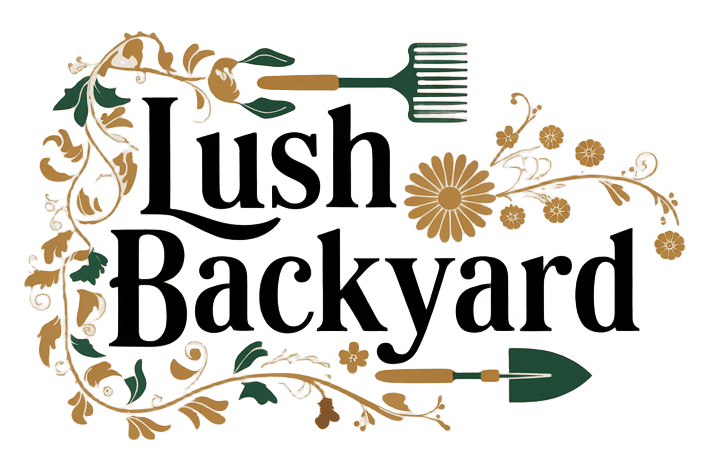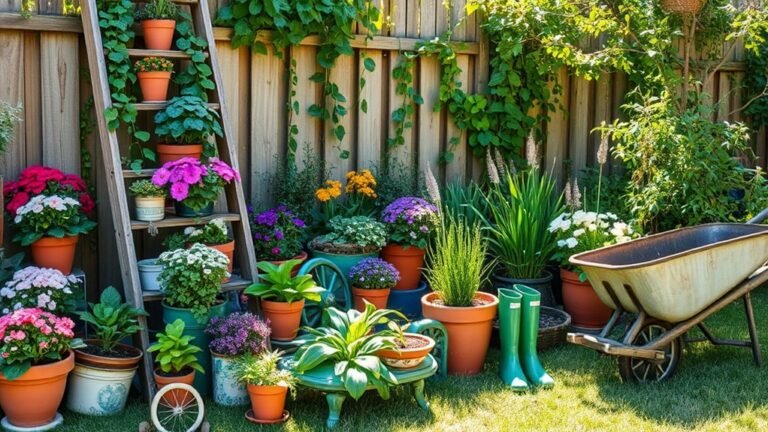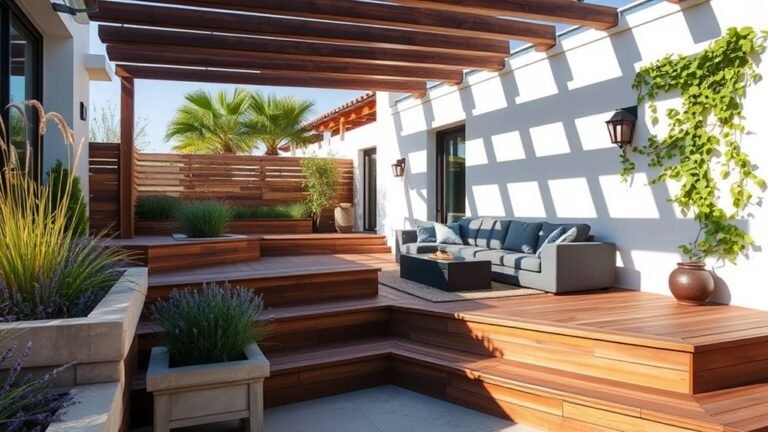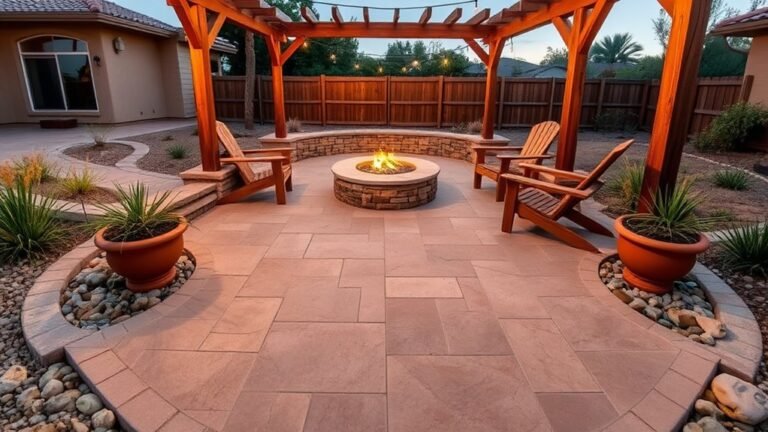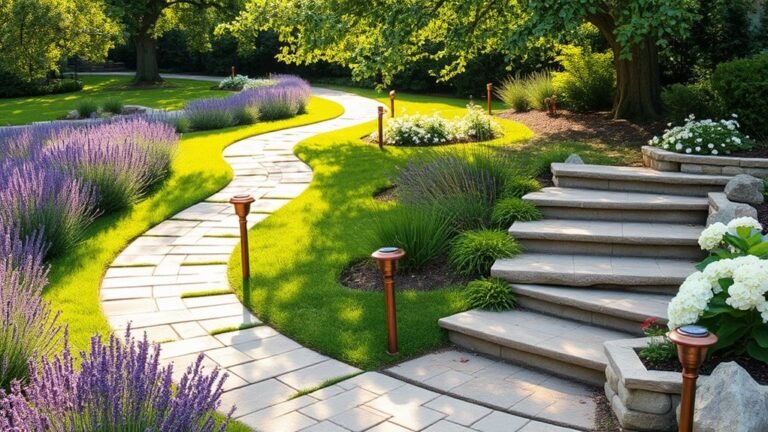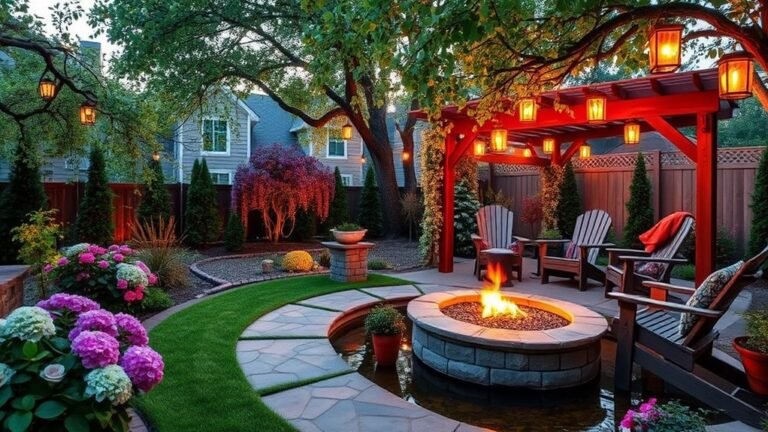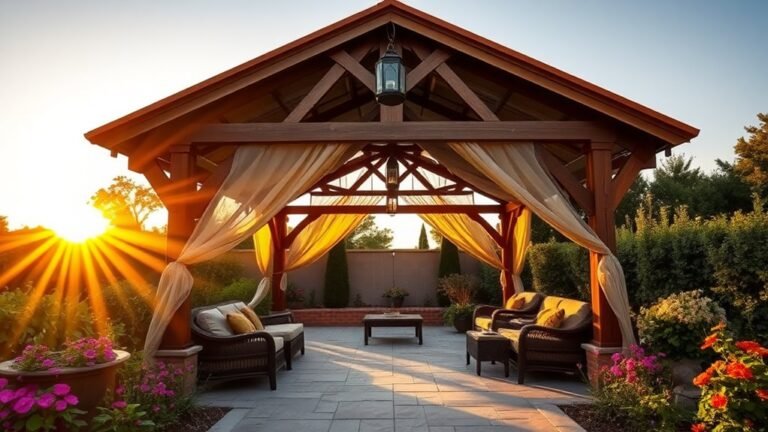12 Small Backyard Grass Ideas for Lush Spaces
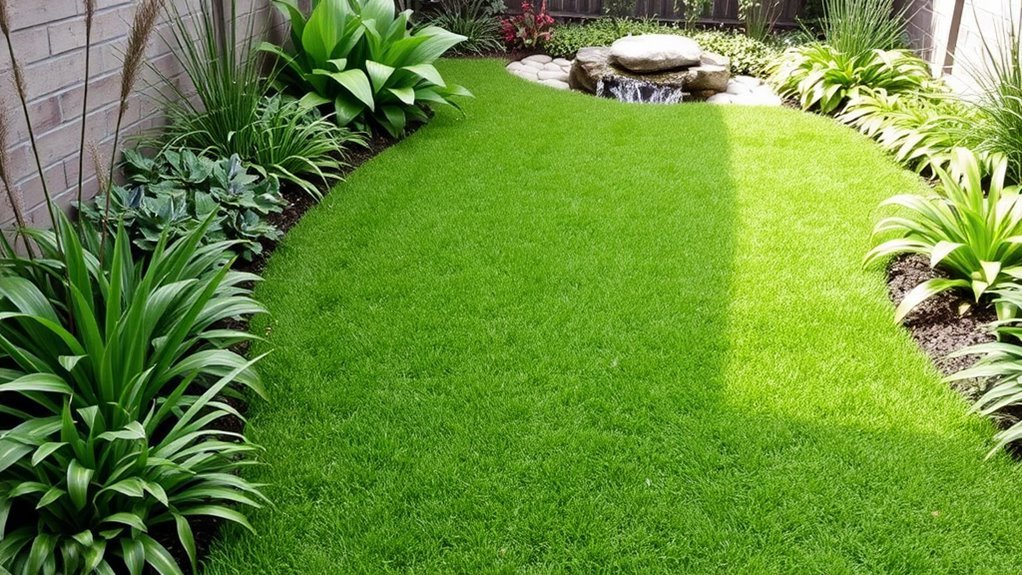
To enhance your small backyard, selecting suitable grass types can create a lush and inviting atmosphere. Consider low-maintenance options like fescue or Bermuda grass, or opt for native grasses to add beauty and eco-friendliness.
Maximizing your area involves clever strategies, such as defining play zones and designing charming pathways. Explore various grass ideas to truly elevate your outdoor space. Incorporating features like decorative planters and vibrant flower beds can further enhance the overall appeal. Additionally, exploring square backyard landscape designs can efficiently utilize space while providing a modern aesthetic. Consider adding seating areas that encourage relaxation and socializing, making your outdoor sanctuary a true retreat.
Choose Low-Maintenance Grasses
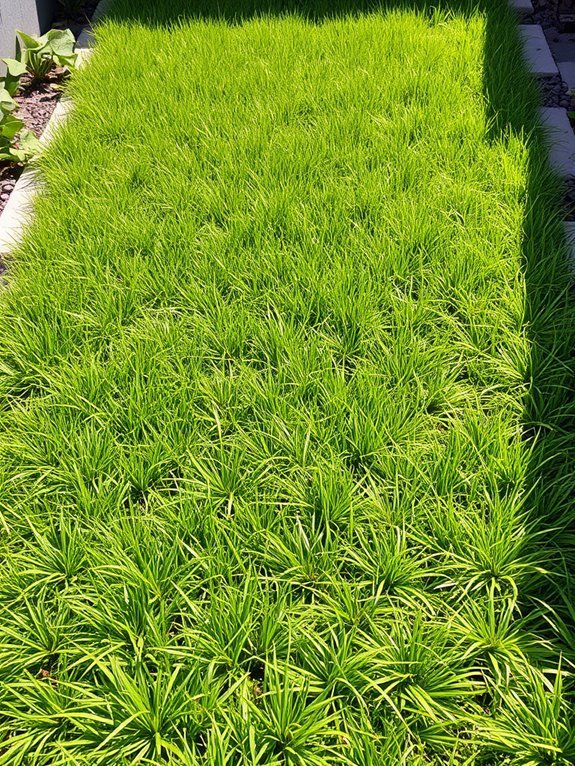
If you want a beautiful lawn with minimal effort, choose low-maintenance grasses. These hardy options, like fescue and Bermuda grass, can thrive in various conditions and take care of themselves.
Fescue is ideal for shady areas and requires less water, while Bermuda flourishes in sunny spots and tolerates heat well.
Low-maintenance grasses save you time and water, allowing you to enjoy your backyard without extensive upkeep.
They're perfect for hosting barbecues, playing with kids and pets, and they can help inhibit pesky weeds, reducing the need for harmful chemicals.
This way, you can maintain a healthy lawn and contribute to a healthier environment.
Embrace a hassle-free lawn and transform your backyard into a vibrant oasis for creating memories!
Incorporate Native Grass Varieties
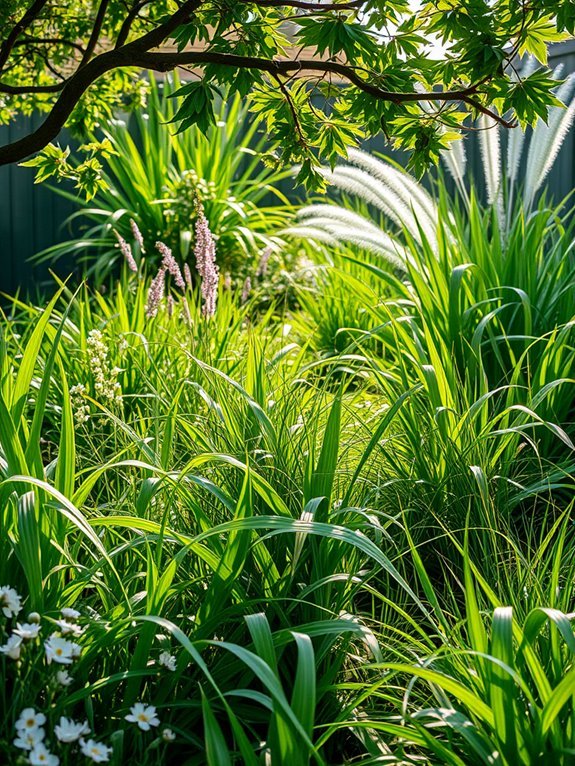
Incorporating native grass varieties enhances your backyard's beauty while supporting local ecosystems. By choosing regionally thriving grasses, you create a lush space that aids wildlife and minimizes the need for watering and chemicals. Native grasses are tough, resilient, and low-maintenance!
Here are some native grasses to consider:
| Grass Variety | Benefits | Ideal Conditions |
|---|---|---|
| Blue Grama | Drought-tolerant | Full sun, well-drained soil |
| Little Bluestem | Beautiful fall color | Full sun, average moisture |
| Switchgrass | Wildlife habitat | Full sun to partial shade |
| Prairie Dropseed | Aromatic, deer-resistant | Full sun, dry to average moisture |
Create Mini Grass Patches
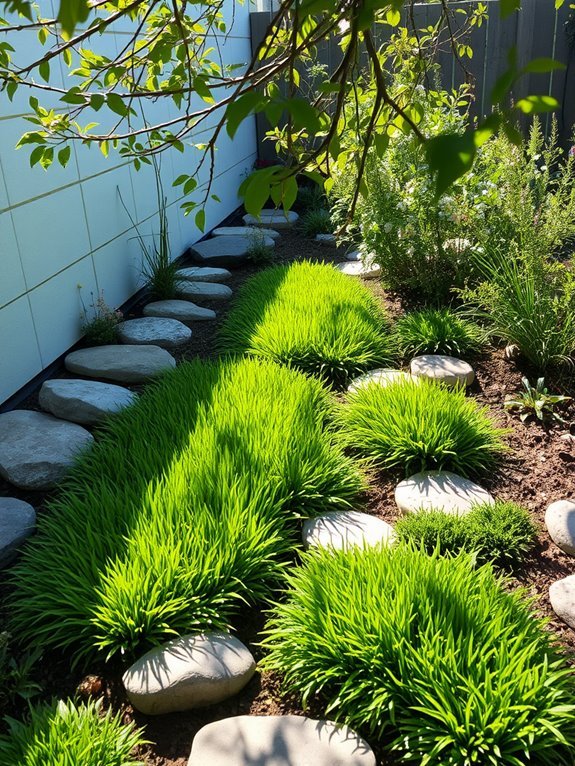
Mini grass patches can enhance your backyard's vibrancy and provide cozy spots for relaxation or play. Here's how to create them:
- Choose Your Spots: Identify areas needing greenery, like sunny corners or shaded nooks, and consider placing them around garden beds for a smooth transition.
- Select Your Grass: Opt for a grass variety that fits your climate and sunlight conditions, such as lush fescue or hardy Bermuda.
- Design It: Experiment with shapes, like round or heart-shaped patches, and surround them with stones or flowers for added charm.
These mini grass patches will elevate your backyard's appeal and create a fun, relaxing atmosphere.
Use Grass as Ground Cover
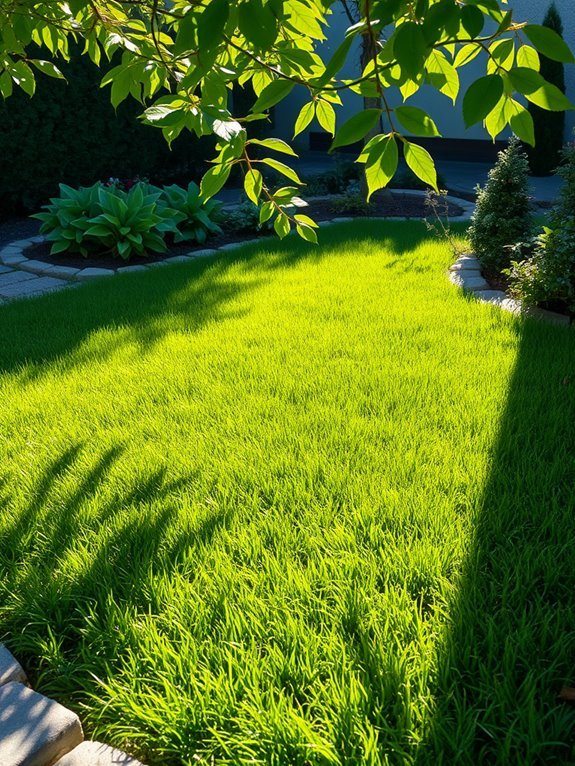
Using grass as ground cover can transform your backyard into a lush, inviting space while suppressing weeds and preventing soil erosion.
Imagine stepping onto a soft, green carpet that feels great underfoot—nature's cozy rug!
Grass serves as a natural barrier against weeds, allowing you to enjoy your yard without spending hours battling them.
It also retains moisture in the soil, helping your plants thrive during hot summer days.
Selecting the right grass variety is crucial.
Look for low-growing options like creeping thyme or fine fescue, which thrive in sunny spots.
Don't forget to include shade-loving types for tricky areas.
Embrace a relaxed vibe; a bit of variation in your grass patch can add character and charm.
Lay down that grass ground cover and watch your backyard bloom into an oasis that will make you smile!
Design a Grass Pathway
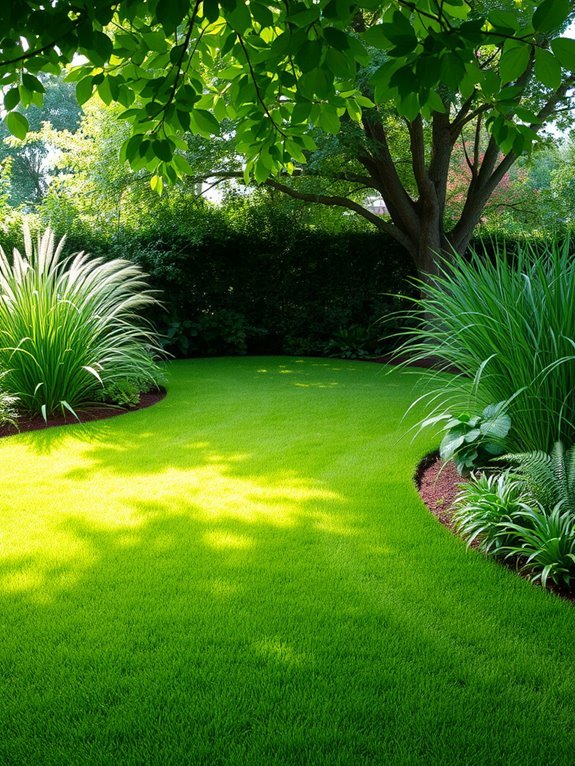
A grass pathway can provide a soft, inviting touch to your backyard, offering a welcoming feel.
Creating a grassy trail is simple and enhances your outdoor space.
Here's how to do it:
- Choose the Right Grass: Opt for durable varieties like fescue or bluegrass that can handle foot traffic.
- Define Your Pathway: Use stones, bricks, or garden borders to outline your path, keeping the grass contained and giving it a polished look.
- Maintain Your Path: Regularly mow and water to keep your grass healthy.
Aerate occasionally to promote strong growth—your pathway will flourish!
Implement Vertical Grass Gardens
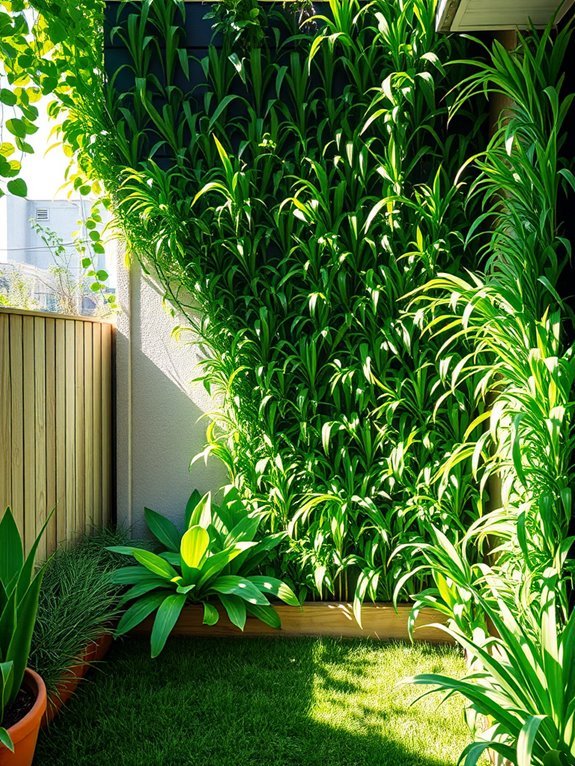
To enhance your backyard's aesthetic and functionality, vertical grass gardens are a brilliant solution. These gardens save space while providing an eye-catching focal point, with lush greenery cascading from wall-mounted planters or shelves.
To begin, arrange planters at various heights using pallets, trellises, or wooden crates. Choose grass varieties that thrive in your region and adapt well to vertical growth.
Here's a quick reference for your vertical grass garden:
| Element | Description | Tips |
|---|---|---|
| Planters | Wall-mounted for grass growth | Ensure good drainage |
| Grass Varieties | Select adaptable types | Prefer low-maintenance |
| Maintenance | Regular watering and trimming | Schedule bi-weekly checks |
| Sunlight | Position for optimal exposure | Monitor light levels |
| Design | Create patterns or layers | Be creative! |
Mix Grasses With Flower Beds
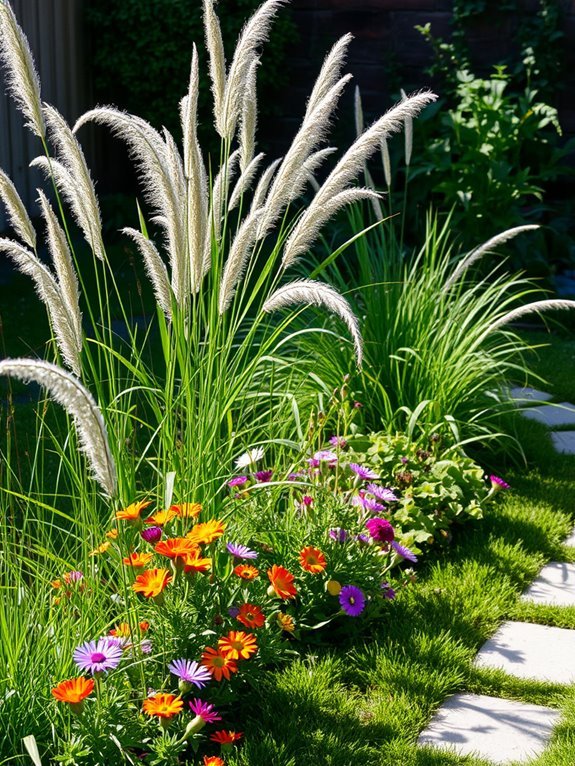
Mixing grasses with flower beds can create a vibrant landscape in your backyard.
By combining different textures and colors, you enhance visual appeal and add depth.
Here are three effective ways to incorporate grasses into your flower beds:
- Layering: Position taller grasses in the back and shorter ones in the front to create a stunning backdrop for your blooms.
- Color Coordination: Choose grasses that complement your flower colors, like pairing soft blue or green grasses with vibrant orange or purple blooms.
- Seasonal Interest: Select grasses that bloom at different times to create a dynamic canvas that changes with the seasons.
Explore Ornamental Grass Options
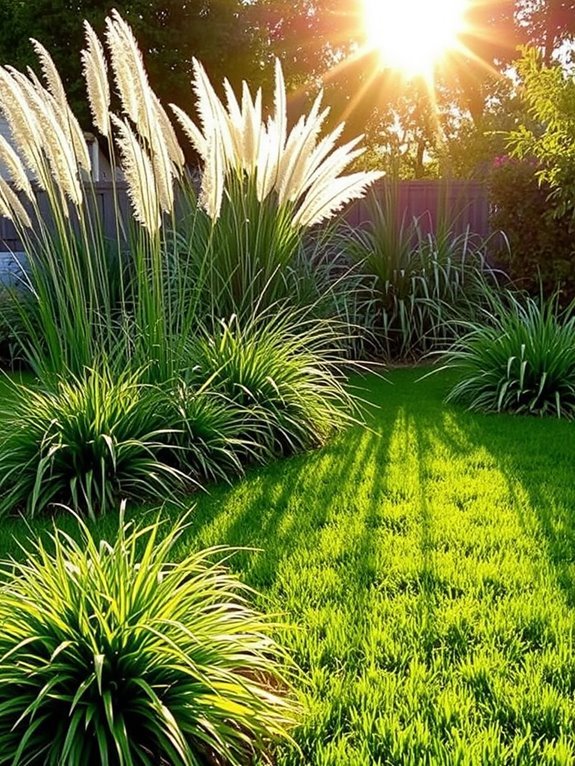
Ornamental grasses can transform your backyard into a lush oasis, adding texture and movement with minimal maintenance. They create a serene atmosphere while attracting butterflies and birds.
When selecting ornamental grasses, consider their height, color, and growth habits. Here's a quick reference:
| Grass Type | Height | Color |
|---|---|---|
| Blue Fescue | 12-18 inches | Blue-green |
| Miscanthus (Maiden Grass) | 3-6 feet | Green with golden plumes |
| Japanese Blood Grass | 2-3 feet | Green with red tips |
Picture swaying grasses dancing in the breeze, enlivening your garden. Grouping different varieties or planting them along pathways can create a stunning effect. Add ornamental grasses to your backyard for a lush, inviting outdoor space with ease!
Add Grass Between Pavers
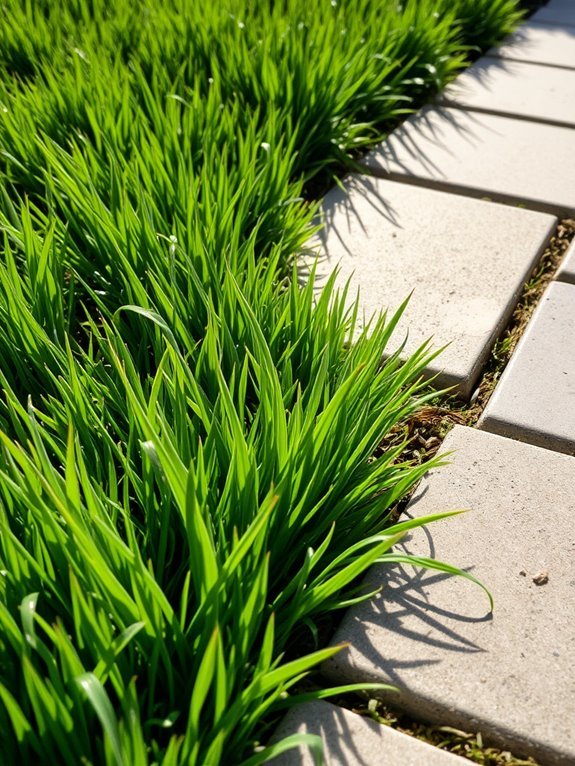
Adding grass between pavers creates an eco-friendly look in your backyard, softening hard surfaces and enhancing nature's presence. In addition to the aesthetic benefits, grass between pavers improves drainage and helps with temperature regulation in your outdoor space. This combination of elements can be further enhanced with creative backyard turf and paver designs, allowing for a seamless blend of textures and colors. Ultimately, this design choice not only transforms the look of your backyard but also supports local ecosystems by promoting biodiversity.
Follow these steps to get started:
- Choose the Right Grass: Select grass that thrives in your climate and fits your paver layout, such as creeping thyme, fescue, or moss.
- Prepare the Area: Ensure pavers are spaced 2-3 inches apart for grass growth. Clear any weeds or debris before planting.
- Plant and Care: Spread grass seeds or small plugs between the pavers and water gently.
Keep the area moist (not soggy) to encourage a lush green carpet between your stones, making your backyard inviting and warm.
Layer Grasses for Texture
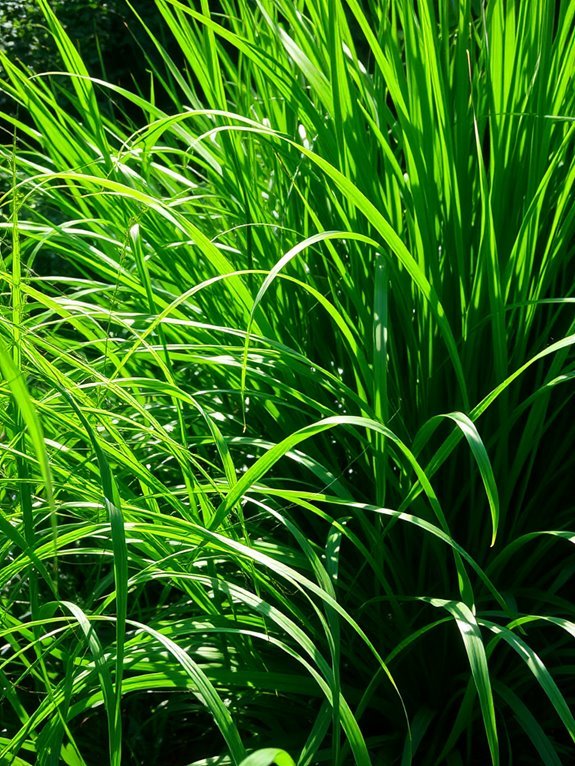
Layering different types of grass can enhance the texture and visual appeal of your lawn. Picture walking through your backyard, feeling the contrast of soft fescue alongside sturdy ryegrass, creating a lush paradise.
Choose grasses with varying heights and textures—taller ones as a backdrop, shorter varieties filling in gaps for depth. Select grasses suited for sunny areas and those that tolerate shade to ensure a beautiful lawn everywhere.
Incorporate ornamental grasses for added movement; they're often drought-resistant, reducing maintenance. Consider grass colors as well—some offer vibrant shades while others provide a calming palette.
Layering grasses promotes not only aesthetics but also a resilient, low-maintenance lawn that will impress your neighbors. So, get started on your layering project!
Utilize Artificial Turf
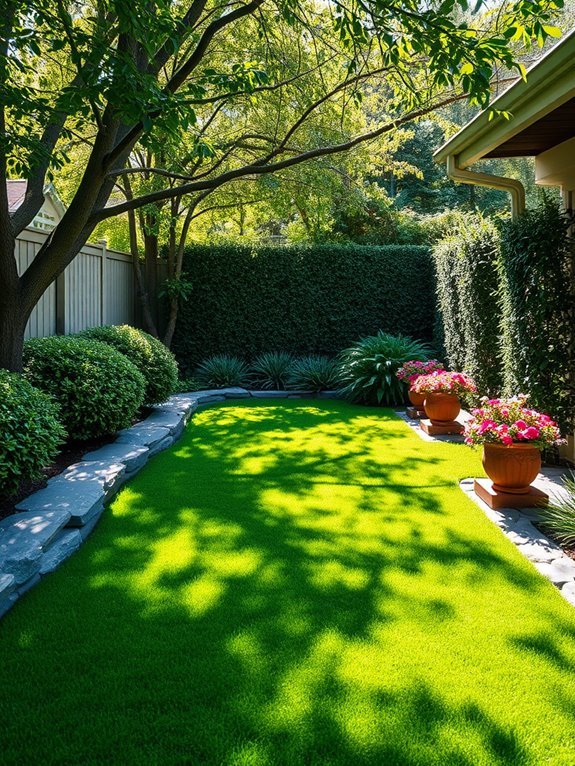
If you're seeking a low-maintenance alternative to natural grass, artificial turf is an excellent choice. It provides a lush, green appearance without the need for mowing, watering, or weed management, making it ideal for small backyards.
Here are three reasons to consider artificial turf:
- Durability: It can handle heavy foot traffic and maintains its appearance year-round, even after gatherings.
- Eco-Friendly: It conserves water and eliminates the need for chemical fertilizers or pesticides, making it a sustainable option.
- Versatility: Suitable for various applications, including pet areas, putting greens, or lounging spaces.
Consider Grass for Play Areas
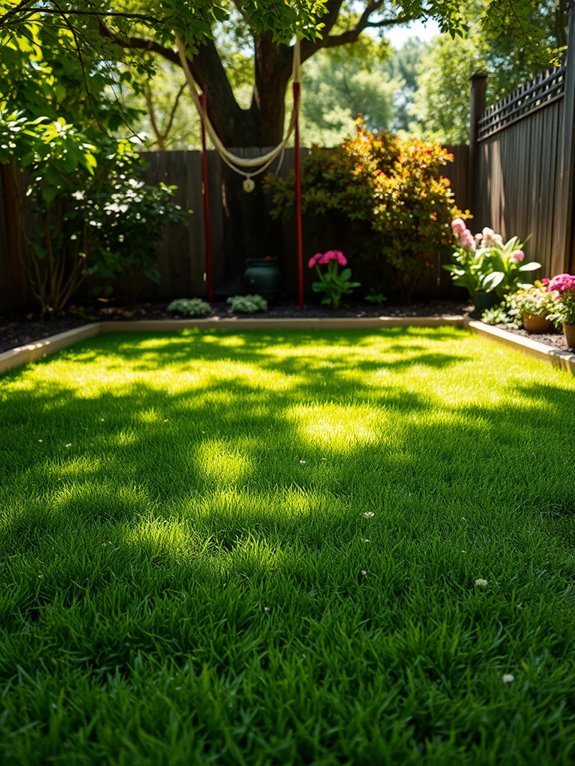
A well-maintained grass area can turn your backyard into a safe and enjoyable play space for kids. Picture them running freely, giggling as they chase insects or kick a soccer ball. Grass offers a soft landing for tumbles, ensuring the fun continues without the worry of scrapes. Incorporating pathways lined with flowers or decorative stones can enhance the area’s charm, providing a beautiful contrast to the lush greenery. For those seeking to maximize the potential of their outdoor space, consider exploring backyard design inspiration with grass that seamlessly blends play with aesthetics. This not only creates a functional environment for children but also a serene retreat for the entire family to enjoy.
You can select from different grass types, like Bermuda or Kentucky bluegrass, both of which are durable and can withstand all the running, jumping, and sliding. They also enhance your yard's aesthetic with their lush green appearance.
Create defined play zones, such as a mini soccer field, a sandbox, or a space for outdoor games like cornhole—transforming your yard into a personal playground!
While the kids play, you can relax with a good book right on the grass, but keep an eye on them; they might come up with some creative new games!
Frequently Asked Questions
What Are the Best Grass Types for Shady Areas?
If you've got a shady spot, don't fret! Some grass types thrive in low light.
Try fine fescue—it's like the ninja of grasses, sneaking in where others can't. Kentucky bluegrass also works well; it loves a bit of shade and spreads like gossip at a party!
Then there's perennial ryegrass, which germinates fast, giving you a quick green carpet.
With these options, your shady area can look fantastic!
How Do I Prevent Weeds in My Grass Garden?
Picture your grass garden as a royal kingdom, where weeds are the uninvited guests at the ball.
To keep them at bay, you'll want to mow regularly, maintain healthy soil, and use mulch to block their sneaky attempts. A good pre-emergent herbicide can work wonders too!
Water wisely, and don't over-fertilize. By staying vigilant, your grass can shine like a star, leaving those pesky weeds sulking in the shadows.
Can I Plant Grass Over Concrete?
You can't just plant grass over concrete and expect it to thrive. Grass needs soil to grow, so you'll need to create a suitable environment first.
Consider removing or covering the concrete, then add soil and nutrients.
If you're feeling adventurous, you could even try planting in large containers or raised beds on top of the concrete. It's a fun challenge, and who knows? You might end up with a quirky garden masterpiece!
How Often Should I Water My Grass?
When it comes to watering your grass, think of it as giving your lawn a revitalizing drink rather than drowning it in a pool!
You should water deeply but less frequently, about once or twice a week. This encourages those roots to dig down, making your grass resilient.
If it's super hot, you might need to give it a little extra love. Just remember, moderation is key—nobody likes soggy socks!
What Tools Do I Need for Grass Maintenance?
To keep your grass looking its best, you'll need a few handy tools!
Grab a reliable lawn mower to keep the height just right. A rake helps remove leaves and debris, while a good pair of garden shears will tackle those pesky edges.
Don't forget a quality hose or sprinkler for watering, and a soil aerator to promote healthy growth.
With these tools, you'll be the grass maintenance pro in no time!
Conclusion
Transforming your small backyard into a lush oasis is easier than you think! With low-maintenance options like fescue and Bermuda grass, you'll spend less time mowing and more time enjoying your space.
Adding native grasses not only enhances your backyard beauty but also supports the environment. So, roll up your sleeves and let your backyard bloom into a vibrant retreat ideal for relaxation or play—because who said small can't be spectacular?
